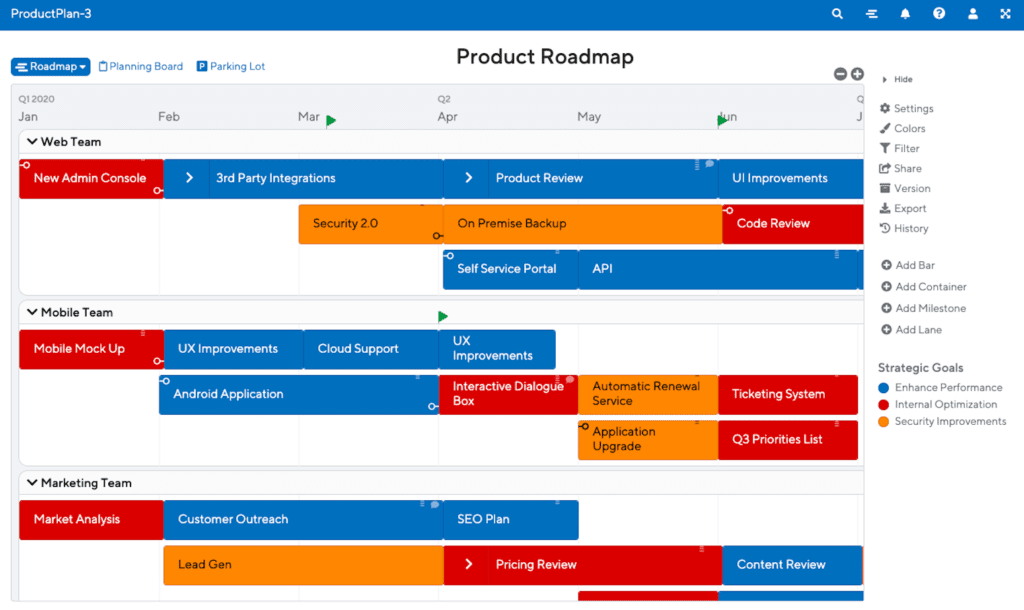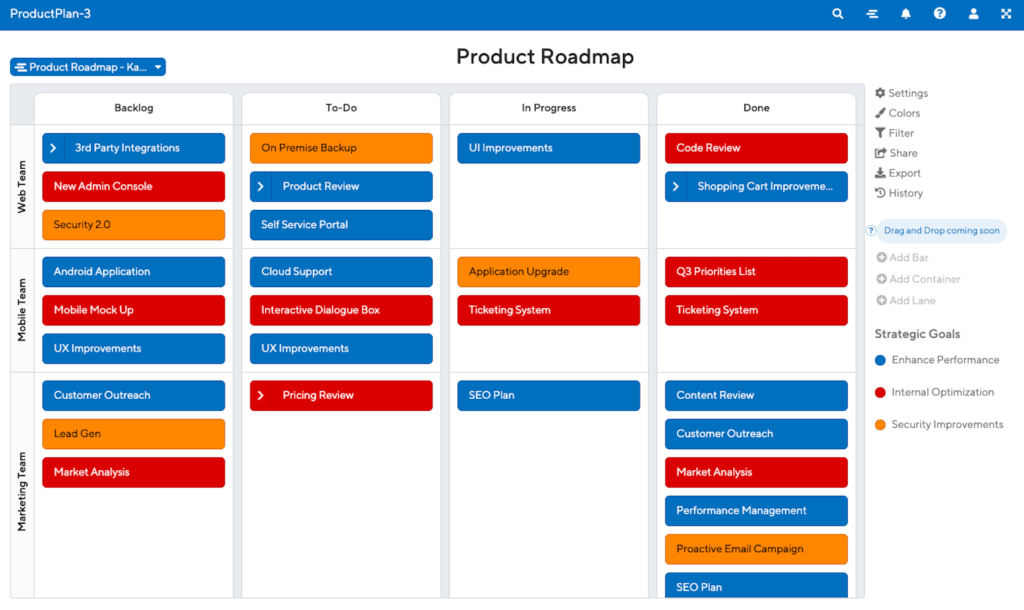If you’re ready to start creating a roadmap, I’ll assume two things. First, your organization has already determined your product’s vision: the big-picture plan for what the product will accomplish in the market and for your company. Second, you and your team have identified a high-level strategy to make that product vision a reality. This strategy doesn’t have to be fully worked out and documented—that’s what the product roadmap itself is for—but you should have already determined the major components of your product strategy and the reasoning behind them.
Why Create a Roadmap
We’ve written in detail about what a roadmap is and what its primary roles are. First and foremost among those roles is to convey a product’s vision and strategy clearly. This means the process of creating a roadmap can’t happen in a vacuum. You and your team can’t simply sit down with the idea of developing a new product and immediately jump into creating a roadmap without clearly understanding that new product’s vision and strategy first.
After all, your roadmap won’t be able to do its job of effectively documenting vision and strategy if those two all-important elements haven’t already been thought through, vetted, and agreed upon.
The early stages of your product development process should follow a clear order of strategic product planning. First, you’ll determine the product’s vision. Then you’ll settle on a high-level strategy for guiding that vision to reality. And finally, you can start creating a roadmap to capture and communicate that vision and strategy.
In this post, we’ll take you through four key things to consider when creating your product roadmap (and will review what oversights to avoid):
- Make sure you’re using the right roadmap tool.
- Make sure your roadmap is visually clear and compelling.
- Make sure a strategic justification accompanies every item on the roadmap.
- Make sure you are reviewing and updating your roadmap frequently.
Recommended reading
If, after reading this introduction, you determine that your team might not quite be ready for creating a roadmap—perhaps you’re still at the strategy brainstorming stage—I’d recommend you download our free book, Product Roadmaps: Your Guide to Planning and Selling Your Strategy. It will walk you through all of the strategic steps to get to a finished product roadmap and beyond.
But if you are indeed ready to create a roadmap, below is a helpful guide to get you started.
4 How to Build a Roadmap
1. Make sure you’re using the right roadmap tool.
The first thing to think about when creating a roadmap is the tool you’ll be utilizing. This is a critical decision to make because if you choose the wrong application to build your roadmap, you’ll be stuck with that application throughout your product’s development. This could lead to untold hours of extra work for you, a roadmap that presents itself poorly, and stakeholders with consistently outdated information.
Although a roadmap is often mistakenly viewed as a static document—something that’s written down once and then left more or less intact—the truth is that a roadmap is a living, dynamic document.
Your product’s priorities will change. Your customers will change. Budgets will change. Your competitive landscape will change. All of these changes need to be reflected on the roadmap, which itself will ideally be easily accessible so any relevant party—development, marketing, sales, executive stakeholders—can view it and gain an up-to-date picture of where the product is in its development journey. If your roadmap tool doesn’t allow for easy updates and easy sharing across the organization, what value does it add?
Yet when we surveyed product managers a couple of years ago to find out how they were creating their roadmaps and their major challenges, we found that the typical PM was still using presentation software and spreadsheets to create a roadmap. And wouldn’t you know, the top challenge these PMs cited when it came to their product roadmaps was that they took far too much time to create and update.
Issues with roadmaps
In case you’re curious, other major issues were that the PMs’ roadmaps were not visually compelling—making it more difficult to use them to win stakeholder buy-in—and the fact that because they were static documents, they often left executives and other stakeholders with outdated information.
Before creating a roadmap, think carefully about the pros and cons of whatever application you’re planning to use. Presentation and spreadsheet software, for example, require manual updates and make sharing more difficult because they output static files that can’t easily be shared and accessed in a central location.
The solution? Use a purpose-built roadmap application—an app designed specifically for creating roadmaps. Look for a tool that considers the need for simple drag-and-drop updates that can be housed online at a single URL for easy sharing and that creates an aesthetically compelling presentation for product meetings with stakeholders, development teams, and other key groups.
2. Make sure you’re creating a roadmap that’s visually clear and compelling.
Imagine creating a roadmap in spreadsheet format—rows and rows of epics and features and stories. Yes, it looks a bit boring, but surely everyone can look past the rows of text in 8-point font and see the genius of your strategy, right?
Maybe.
As a product manager, one of your key jobs is to be an evangelist for the product. A high-level visual presentation is a powerful way to help get buy-in on your strategy.
In fact, some product teams care so much about creating the right impression that they spend hours creating a visually beautiful roadmap. We regularly hear stories about how much the presentation matters. For example:
- The VP of Product had a designer use Adobe Illustrator to create their product roadmap document. (Unfortunately, the designer needed to be involved in every change).
- The product managers who enlisted the marketing department’s help in creating a roadmap—and the document was so beautiful that they continued using it even after the roadmap’s information was outdated!
- Each month, the product owner spent hours re-formatting and color-coding a spreadsheet to convey how the roadmap tied to the strategy.
These teams understood the value of the visual—so much so that they spent an inordinate amount of time and resources creating a roadmap specifically to present well.
But in today’s agile world, there isn’t time to hassle with updating a graphic, PowerPoint deck, or spreadsheet every time the roadmap is updated or your executives want to review it.
The value of a dedicated roadmap software
This is why my first suggestion was to be very strategic in choosing the tool to build your roadmap. Dedicated roadmap software will be designed to help you make a visually compelling case for your product strategy.
Regardless of which tool you choose to create your roadmap—a presentation tool, a word-processing app, spreadsheet software, or a purpose-built roadmap app—here are a few suggestions for creating an impactful roadmap.
- Use color. Color is a great way to represent how your roadmap ties to the product vision or strategic objectives. Color-code each item on your roadmap to help people make the connection between each initiative and how it fits into the big picture.
- Use large fonts. People have a limited amount of time to digest your strategy, so use large fonts, especially if you present your roadmap on a projector or in an online meeting. Think of your roadmap like a presentation, and you’ll be ahead of the game.
- Keep it high-level. Remember that you are telling a story about how your strategy fits with the product vision. So tell the story in big, bold strokes rather than minute details. If you can, create logical groupings of initiatives to make the roadmap easier to grasp.
create a Roadmap template
3. Make sure a strategic justification accompanies every item on the roadmap.
As we’ve written before, a roadmap is not simply your product’s backlog or feature list. Your roadmap should provide a clear and persuasive case for building the product the way you ask for it to be built.
With this in mind, it is a smart strategy to find ways to have your roadmap include your reasoning behind each of the themes, epics, and other initiatives you’ve chosen to include. If it’s on the roadmap, your team and anyone you’ve given access to view the roadmap should be able to learn why you’ve chosen to prioritize it.
Tweet This:
“Make sure every item on the roadmap is accompanied by a strategic justification.”
There are several benefits to this approach. First, when you set a rule that any item needs to articulate its reason for existing on the roadmap, your team will be more strategic in your product decisions. Second, when you have a clear explanation on the roadmap for why every item belongs there—even if it’s just a single line, i.e., “Research tells us 84% of our customers use mobile apps for work,” to explain the reason for prioritizing a mobile version of your product—you are more likely to earn stakeholder buy-in.
4. Make sure you are reviewing and updating your roadmap frequently.
Assuming you take the advice in this post and select a dedicated roadmap application for creating your roadmap, rather than a static-document tool like PowerPoint or Excel, you will find updates to the roadmap quickly and easily.
As you can see from the screenshot above, adding an epic story, switching priorities, or moving a set of tasks from one team or swim lane to another should be as simple as dragging and dropping color-coded bars or containers into the appropriate spot on the roadmap.
Likewise, with the right roadmap tool, checking the status of an item or assigning it a category should be possible with a couple of clicks.
The point? With the right roadmap tool, you’ll have no excuse for not updating the roadmap as often as necessary. This plays such a critical role in the success of your product in each of its development steps.
Risks of not updating your roadmap
Failure to regularly update your roadmap could mean that everyone on your cross-functional team might be working with outdated or incorrect information leading to repeated questions, confusion around initiatives, and general misalignment.
When a roadmap lives in the cloud, there are no version-control problems because you will always know that everyone in your company has an accurate picture of where the product stands, what they should be working on, and which priorities may have changed. There is no need to be exporting, resending .pdfs, or searching for email threads to send the updated roadmap after making a minor change. It will be up to date anytime anyone looks at it.
Let’s also look at the most common oversights I see product managers make when they create a roadmap and the effective ways to avoid them.
4 Oversights to Avoid when Creating a Roadmap
1. Failing to include your strategic plan front and center of your roadmap’s main view.
You will be updating and referring back to your roadmap throughout development, which might take place over a long timeframe. Are you sure that six months into the process, you’ll remember exactly why you placed “Upgrade Security Backend” at the top of the list?
Additionally, when you’re presenting this roadmap to your executive stakeholders or your sales team, for example, wouldn’t it be more powerful and persuasive if you had the strategic basis included right in your presentation, which your audience could see at a glance, right below each theme or epic?
In this case, a simple line below your “Upgrade Security Backend” might state, “Data suggests this might enable us to tap into the healthcare market for the first time.” This way, in your initial meetings and throughout the development process, your roadmap will quickly explain to anyone looking at it exactly why that theme deserves its priority slot.
2. Failing to include evidence that supports your strategic reasoning in your roadmap.
Product managers often either keep the evidence they’ve compiled in other documents, or they don’t think about those data at all when they’re crafting their roadmaps.
The problem with this oversight is that in a meeting where you’re presenting your roadmap — say, to your executive stakeholders — when someone in the room sees the theme described above and the strategic reasoning behind it. They might ask you, “Okay, I see you’ve listed a reason for prioritizing a cybersecurity upgrade. But is that your gut instinct telling you it’ll allow us to break into the healthcare market? What evidence do you have?”
If you don’t have the evidence ready, you can lose that all-important momentum in the meeting as you fumble around looking for it on your laptop.
If you have that data visible and accessible to anyone viewing your roadmap at any time, it can make a significant difference in giving credibility to your strategic plan. With the right roadmap software, including data is as simple as attaching a note to your theme or epic, which, when clicked, can bring up a graph, chart, document, or link to your data.
3. Including granular dates too far out on your roadmap.
A common oversight in product roadmap creation is thinking in this initial stage that everything in your development will play out precisely according to plan. Therefore the roadmap is crafted with set-in-stone dates and promises, even for items planned far into the future.
When you place firm dates on your roadmap, particularly for items not slated for development until several cycles down the road, you’re setting up your company for disappointment, if you do decide to include dates on your roadmap, you want to make sure to build the roadmap in such a way that you can change or remove them when circumstances change, and those dates are no longer reasonable.
This is another reason to find a native roadmap tool and not force a roadmap into the wrong application. When you use a purpose-built roadmap tool, creating, editing, shifting, and removing dates is as simple as a few clicks. In other words, you won’t have to rebuild the entire document or move enormous amounts of stories around when your dates need to change.
4. Not referring to your roadmap throughout the development process.
Your development will be a fluid process, subject to changes at any time from your company or the market. For this reason, you need to think of your roadmap as a living document.
That means you should update the roadmap whenever there is a material change in plans or priorities. These updates will be critical if you share your roadmap with the relevant teams across your company (which you should be doing). If they are looking at an outdated roadmap, which no longer reflects the latest details or priorities, it can lead to problems.
And this leads to one final reason that investing in a purpose-built roadmap tool can be such a strategically smart decision: The right roadmap tool will be designed for sharing across an organization. That could mean allowing you to host the roadmap on a secure URL, house it through your company’s intranet in, for example, Confluence, or choose from a host of other options to create a single source of truth document for your entire company — without version control issues or the need to update more than a single roadmap, ever.
For more ideas about what to include when creating a roadmap and how to vet each of these items before giving it precious roadmap real estate, read our blog post: Must-Haves Before an Item Makes it on Your Roadmap.








